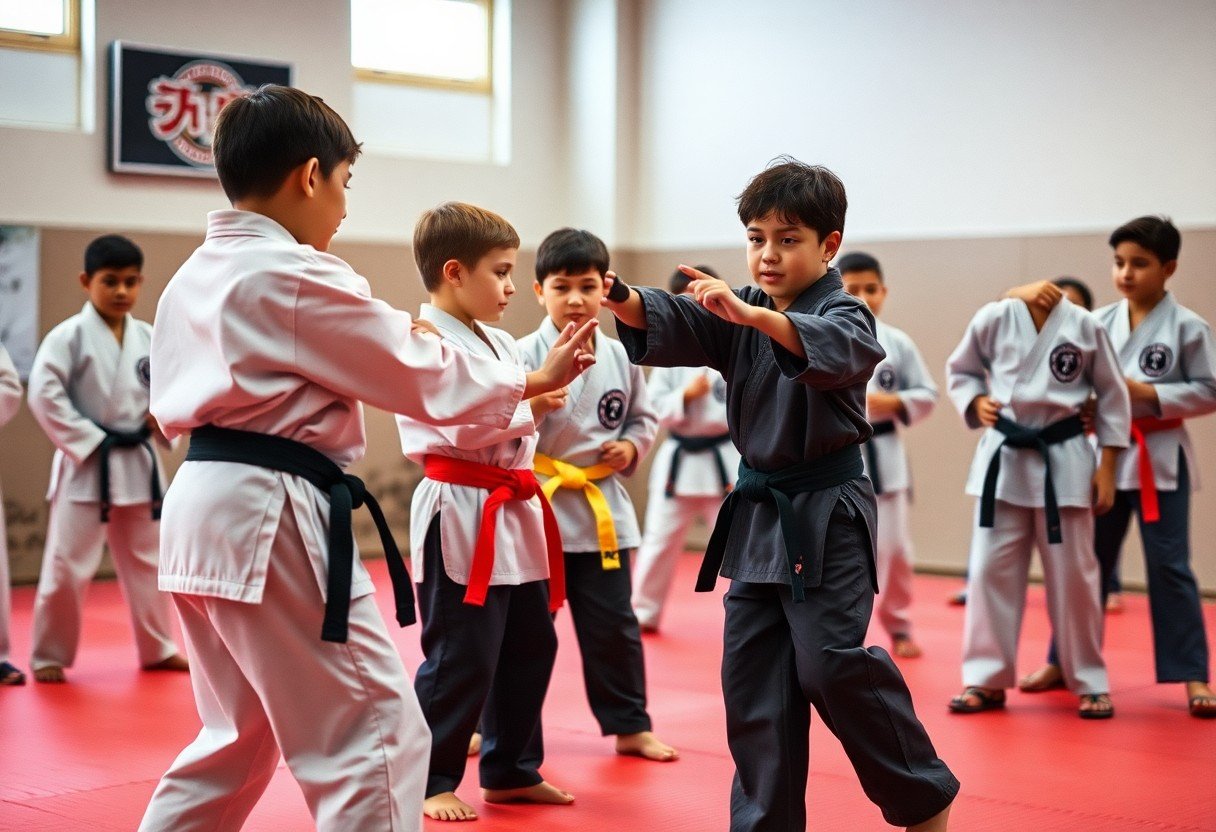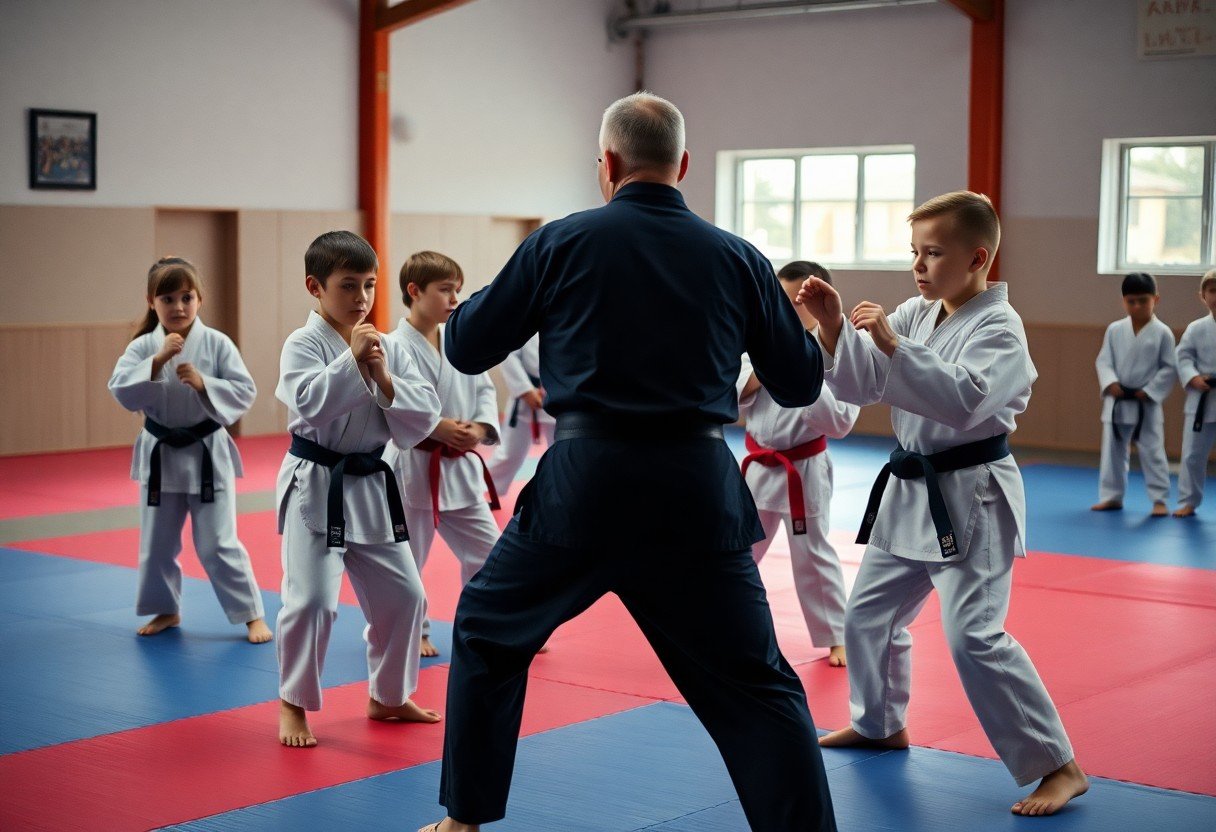Kids engaging in martial arts can experience a multitude of benefits, from improved fitness to enhanced focus. However, it is important to prioritise safety to avoid injuries during training or competition. You should always wear the appropriate protective gear, such as mouthguards and padded gloves, to minimise risks. Ensure that your training environment is safe and well-maintained, and listen to your instructor’s guidance diligently. By adopting these practices, you will foster a secure and enjoyable martial arts journey.
Understanding Martial Arts for Kids
For many children, practising martial arts provides a unique opportunity to develop discipline, focus, and respect. Engaging in this physical activity helps your child learn vital self-defence skills while promoting a healthy lifestyle. Moreover, martial arts can build confidence and enhance social skills, as children often work in teams or pairs during training sessions.
Benefits of Martial Arts
Along with improving physical fitness, martial arts teaches valuable life skills such as perseverance and goal-setting. Your child will cultivate self-discipline and enhance their ability to concentrate, which can translate to better performance in school and other activities. The supportive environment of martial arts also fosters friendships and camaraderie among peers.
Common Risks and Injuries
Any physical activity comes with risks, and martial arts is no exception. While injuries are generally minimal, you should be aware that common issues include sprains, strains, and bruises. Children may also experience more serious injuries if proper techniques are not followed or if they are not adequately supervised during practice.
It is vital to take precautions while your child is learning martial arts. To avoid injuries, ensure they have the appropriate protective gear and that they participate in classes led by qualified instructors. Furthermore, paying attention to your child’s physical limits and recognising signs of fatigue can help prevent overexertion. By promoting a safe training environment and adhering to safety guidelines, you can minimise the potential risks associated with martial arts.

Essential Safety Gear
Now, ensuring your child has the right safety gear is vital for their protection during martial arts practice. The right equipment can help prevent injuries and make their training experience enjoyable. Investing in quality gear not only demonstrates your commitment to their safety but also enhances their performance and confidence as they learn new techniques.
Protective Equipment
Before your child steps onto the mat, it’s important to equip them with the necessary protective gear. This typically includes items such as headgear, shin guards, mouthguards, and boxing gloves. These pieces of equipment play a significant role in minimising the risk of injury by cushioning blows and shielding vital areas of the body.
Proper Attire
With the right attire, your child will not only look the part but also perform optimally in their training sessions. Martial arts uniforms, such as gis or doboks, are designed specifically to provide both comfort and ease of movement while practising techniques.
This suitable attire helps in preventing accidents, allowing your child to focus entirely on their practice. Ensure that the uniform fits well and is made from breathable material to allow freedom of movement during physical activity. Additionally, avoid clothing with loose ends or embellishments, as they may pose a risk during sparring. The right gear and attire empower your child to train confidently while prioritising their safety.
Supervision and Instruction
Any child practising martial arts should always be under proper supervision and receive quality instruction. Ensuring that your child participates in classes led by qualified instructors is crucial for their safety. It helps to foster a structured and encouraging environment where techniques are taught correctly, reducing the risk of injury. Regular observation of the class dynamics and instructors’ approaches can provide insight into how well your child is being taught.
Importance of Qualified Instructors
Behind every successful martial artist is a qualified instructor who not only teaches techniques but ensures a safe learning environment. Instructors with proper credentials will possess the necessary knowledge and experience, which is vital for providing effective training while keeping safety a priority. They can spot potential hazards and take appropriate action to prevent injuries.
Role of Parents in Oversight
Instructors are not alone in ensuring your child’s safety; parents play a pivotal role in monitoring their child’s martial arts journey. By staying engaged and attending classes, you can better understand the practices and values being imparted. Your involvement can encourage your child to take the training seriously while also allowing you to address any concerns with the instructor.
Further, it is beneficial for you to communicate openly with both your child and their instructor. Establishing a balanced relationship can help create an atmosphere where your child feels comfortable expressing any issues, concerns, or discomforts. By understanding your child’s progress and struggles, you can provide additional encouragement and support. Regularly checking in on their development not only promotes a sense of thriving but also ensures that risks are mitigated effectively, fostering a positive and safe learning environment.
Physical Preparation
Despite the energetic nature of martial arts, adequate physical preparation is imperative to ensure your child’s safety during practice. It is vital to educate your young martial artist on the importance of warming up, conditioning, and injury prevention. For further guidance, check out How To Keep Your Martial Arts Classes Safe.
Warm-Up and Stretching
Around 10 to 15 minutes of warm-up exercises and stretching should precede any martial arts class. These activities prepare the body, increase blood flow to muscles, and improve flexibility, considerably reducing the risk of injury. Ensure your child focuses on all major muscle groups to maintain a full range of motion.
Importance of Conditioning
With consistent training, conditioning builds strength and stamina, which are paramount in martial arts. Conditioning lessens overall fatigue during practice, allowing your child to perform techniques effectively. Maintaining an adequate fitness level lays a solid foundation for further skills development.
Understanding the significance of conditioning can transform your child’s martial arts experience into a safer and more effective journey. A well-conditioned body can help prevent injuries by increasing muscle resilience and joint stability, while expanding their ability to execute movements with precision and control. Additionally, improving conditioning encourages your child to remain active and engaged, ultimately fostering a lifelong appreciation for physical fitness and martial arts.
Establishing Safe Training Practices
Unlike many sports, martial arts involve close physical contact and striking, making it crucial to establish safe training practices. You should ensure that all techniques are taught by qualified instructors and are appropriate for your child’s age and skill level. Creating clear rules and guidelines helps maintain discipline and promotes a safe learning environment. Regularly reviewing and adapting these practices will also reinforce their importance and ensure the well-being of all participants.
Safe Training Environment
Before your child begins practising martial arts, it’s vital to create a safe training environment. Ensure the training area is free from hazards and has adequate space for exercises and sparring. Use appropriate mats and protective gear to minimise injury risks. Regularly inspect the training equipment and facilities to maintain safety standards, allowing your child to focus on learning and improving their skills.
Importance of Communication
Establishing open lines of communication between you, your child, and their instructors helps create a supportive training atmosphere. Make sure your child feels comfortable expressing their thoughts and concerns regarding their martial arts practice, allowing for immediate feedback on any issues they encounter. Ongoing discussions around their experiences can foster a positive relationship with the art and its practitioners.
With effective communication, you deepen your child’s understanding of both the techniques and the values of martial arts. Encouraging your child to voice any discomfort or fear can pinpoint areas needing improvement or adaptation. You and the instructor can work together to address these concerns, ensuring that your child feels supported and safe throughout their training journey. This communication not only promotes safety but also enhances learning and confidence, crucial for their martial arts development.
Emphasizing Respect and Discipline
To foster a safe and constructive environment for your child practising martial arts, you must emphasise the importance of respect and discipline. These core values not only aid in effective learning but also help in building strong character. It is vital to teach your child that respecting their instructor, peers, and the martial arts itself will enhance their experience. For more insights on keeping your child secure while training, check out Karate Classes: How To Keep Your Child Safe.
Mental Preparedness
Discipline plays a significant role in preparing your child mentally for martial arts training. By instilling the habit of perseverance and focus, you help them develop a resilient mindset. This mental preparedness equips them to handle challenges both in and outside the dojo, allowing them to flourish in their martial arts journey.
Conflict Resolution Skills
Skills developed through martial arts extend beyond physical techniques; they encompass invaluable conflict resolution abilities. Your child will learn to assess situations critically and respond effectively, equipping them with the tools to navigate life’s challenges.
It is crucial to harness these conflict resolution skills in a positive manner. By understanding how to de-escalate disputes and communicate openly, your child will feel more confident in dealing with confrontations. This training helps them to recognise when to walk away from potential danger, promoting not only their safety but also that of their peers. These skills can serve your child well into adulthood, guiding them in maintaining peaceful interactions in various life situations.
Final Words
With this in mind, ensuring your child’s safety while practising martial arts is of utmost importance. You should encourage them to follow their instructor’s guidance closely, wear the appropriate protective gear, and maintain a focused mindset during training. Always monitor their physical and emotional well-being, and teach them the value of respect and discipline within the martial arts community. By fostering a safe and supportive environment, you can help your child gain not only skills but also confidence and resilience.
FAQ
Q: What safety equipment should my child wear when practising martial arts?
A: It is important for children to wear appropriate safety equipment to minimise the risk of injury during martial arts training. Essential gear typically includes a mouthguard to protect their teeth, headgear to shield the head from impacts, shin guards for leg protection, and durable martial arts uniforms that are suitable for the sport. Additionally, protective gloves may be necessary depending on the specific type of martial arts being practised.
Q: How can I ensure that my child is learning in a safe environment?
A: To ensure a safe learning environment, it is advisable to select a reputable martial arts school that emphasises safety in their training. Observe the classes to see if the instructors prioritise proper warm-up, cool-down procedures, and use of protective gear. It’s vital that the training area is clear of hazards, mats are in good condition, and instructors have appropriate qualifications and experience in teaching children.
Q: What should I do if my child feels uncomfortable during training?
A: If your child expresses discomfort during training, it is important to listen to their concerns. Discuss the issue with them and encourage open communication about what specifically is causing their discomfort—be it the environment, a training partner, or the techniques being taught. It may also be beneficial to speak with the instructor to address any issues and ensure the training approach aligns with your child’s needs and comfort level.
Q: How can I teach my child to respect their training partners?
A: Teaching respect for training partners can be achieved through open discussions about the importance of teamwork and sportsmanship in martial arts. Encourage your child to acknowledge the efforts of others, share positive feedback, and engage in constructive communication. Role-playing scenarios and emphasising the concept of safety during practice can also help instil a sense of respect and responsibility towards their fellow martial artists.
Q: What should I do if my child gets injured during practice?
A: If your child sustains an injury during martial arts practice, the first step is to assess the situation. If the injury appears serious, seek immediate medical attention. For minor injuries, such as sprains or bruises, apply ice and rest the affected area. Follow up with your child to discuss how they feel and if they wish to continue training after recovery. Additionally, it is advisable to talk to their instructor about the injury to ensure future training is adjusted accordingly to prevent recurrence.



